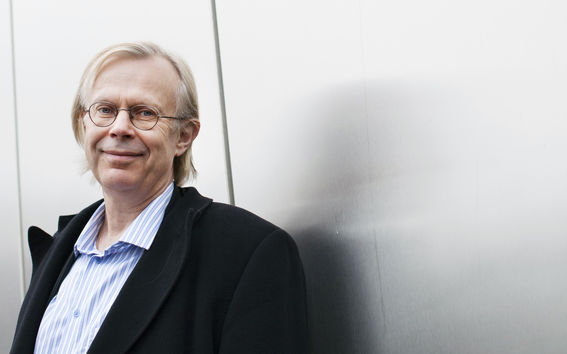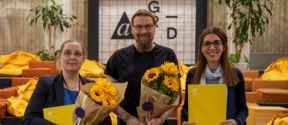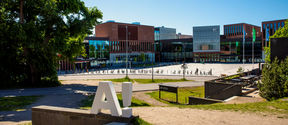Learning from nature

Elements like hydrogen, carbon and silicon are familiar research subjects for physicists. The desire to understand them has given birth to an enormous amount of scientific insights and technological breakthroughs. The The materials of living beings are less familiar to them.familiar to them.
“Simplifying just a little, it can be said that they are complicated for physicists: they have lots of part that interact with one another, they react to stimuli and they have many functions, some of which can even be contradictory. However, an understanding of what a treasure trove our living environment is for physicists and materials scientists has begun to emerge in recent times,” Olli Ikkala says.
With a distinguished career in industry and science behind him, the Academy Professor knows what he's talking about: he heads the Academy of Finland Centre of Excellence in Molecular Engineering of Biosynthetic Hybrid Materials and, with multimillion euro funding from the European Research Council, is developing new functional materials. The treasure trove contains inspiring examples for them that have come about as the result of millions or billions of years of evolution.
“Nature produces material like silk, which is strong, resilient and light at the same time. It has developed dirt-resistant surfaces, self-repairing materials, joints with minimal friction, excellent colour-creating mechanisms and organisms that move around in many different ways. The number of factors involved in the construction and regulation of natural materials is astronomical, making it impossible to understand them completely. But what if we could cherry-pick, choose and grasp only the key mechanisms and use them to develop improved materials?”
Interdisciplinary, naturally
The field of science that tries to copy the way in which nature forms materials Olli Ikkala is describing is called biomimetics. One of its most important tools is self-assembly, a typical characteristic of biological materials, where a coded interaction existing between structural components makes them form nanostructures of a specific kind. This is how nature creates, for example, mollusc nacre, the shell of a crab and the amyloid plaques that develop in the brain of an Alzheimer's sufferer. All of them have mechanical properties that approach those of metals.
Olli IkkalaGood fundamental research requires a profound understanding of the laws of nature.
“We want to make biomimetic materials, which combine strength, resilience and lightness, but also create materials that have properties of an entirely new kind,” Ikkala says and underlines that the inter-disciplinary approach in vogue in academia comes naturally for biomimetics – drawing the line between biochemistry, chemistry and physics is unnecessary, even impossible.
Unnecessary boundaries should be avoided elsewhere, too.
“I don't believe in a strict separation of fundamental and applied research. Good fundamental research requires a profound understanding of the laws of nature, and fundamental research and commercial aims are not mutually exclusive. Theoretical physicist Alan Heeger, winner of the Nobel Prize for chemistry, commercialises solar cells, while another theoretical physicist, Ludvik Leibler, is modernising the methods of surgery.
I've had the pleasure to deal with both of these men. We, too, want to both publish our research in the finest journals and launch new business activities,”Ikkala stresses.
We'll have to wait for biomimetic materials for industrial production to emerge, but promising candidates already exist. One such is a nacre-like material developed by Ikkala's research group. Its manufacturing process is largely based on self-assembly. It consists of nanometre-thick clay sheets that are covered by a nanometre-thick polymer layer that form an extremely strong layered structure.
“We're exploring new application possibilities for this material in cooperation with the School of Arts, Design and Architecture.”
Light and renewable
So what are new materials needed for? At least for the development of a more energy-efficient society: lightness would be very beneficial for transport, for example. Making an ordinary passenger air plane that flies 3,000 hours per year just 100 kg lighter would save 9 tonnes of kerosene and cut carbon dioxide emissions by almost 29 tonnes per year.
The need to replace non-renewable natural resources with renewables is also spurring development. Finland has plenty of forests, but your basic pine tree cannot serve as the high tech material of the future as is.
“This, for example, isn't very strong,” Ikkala says and knocks on the table.
“If, however, I splice it into smaller and smaller parts, I'll eventually get cellulose fibres that are five nanometres thick and have absolutely phenomenal properties, and one can start to compile a new kind of material from them. But a profound understanding of self-assembly and the interactions between molecules is needed for the creation of entirely new types of properties.”
It is believed that nanocellulose will have a wealth of applications in, for example, the forest, furniture, construction and pharmaceuticals industries. It's no surprise that nanocellulose and its applications are being studied actively by Ikkala's group and elsewhere at Aalto University.
“We have to discover alternatives to the paper industry. Our forests contain lots of renewable natural materials – why not develop them into something entirely new and fantastic?”
The interview was first published in Aalto University Magazine May 2015.
Read also: Olli Ikkala appointed Aalto Distinguished Professor
- Published:
- Updated:
Read more news

Aalto Open Science Award ceremony brought together Aaltonians to discuss open science
Last week we gathered at A Grid to celebrate the awardees of the Aalto Open Science Award 2023 and discuss open science matters with the Aalto community.
Seed funding available to boost collaboration between Aalto, KU Leuven and University of Helsinki
Aalto University, KU Leuven and the University of Helsinki launch the 2nd exploratory seed funding call to explore research collaboration possibilities. The funding call is open until 10 September 2024.
Professor Peter Hans Matthews works as a Fulbright-Aalto Distinguished Chair scholarship holder at the Department of Economics
Fulbright programmes and scholarships are highly appreciated in the United States